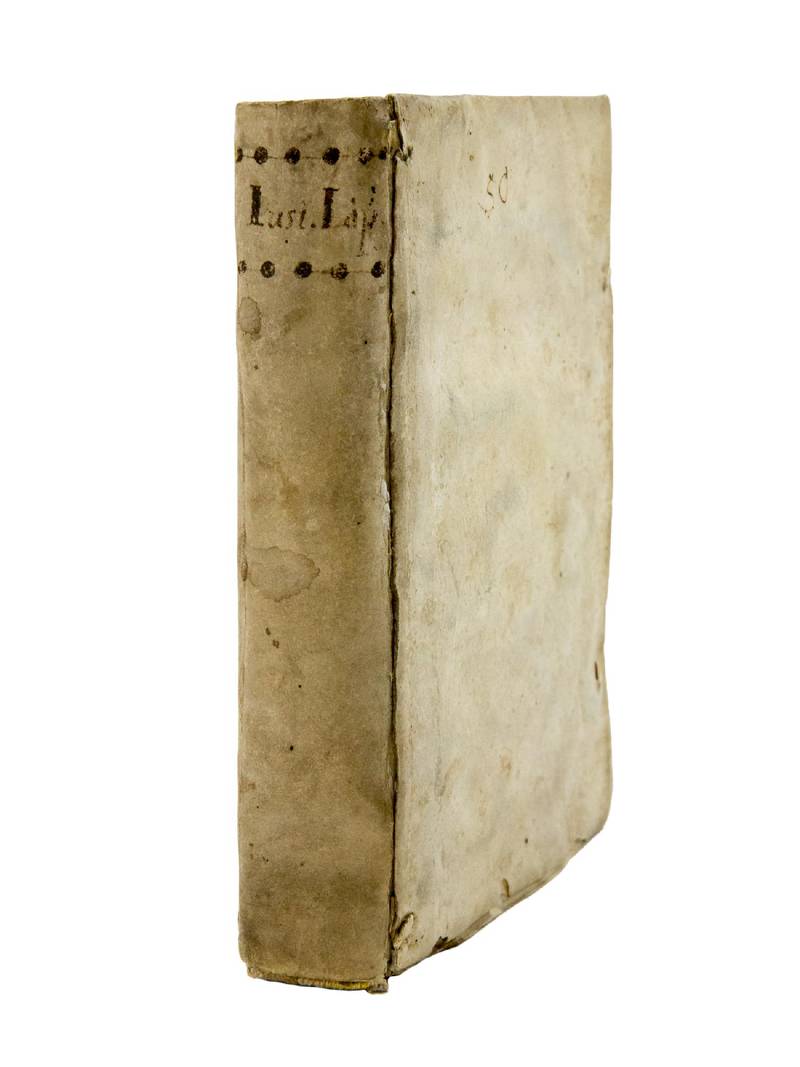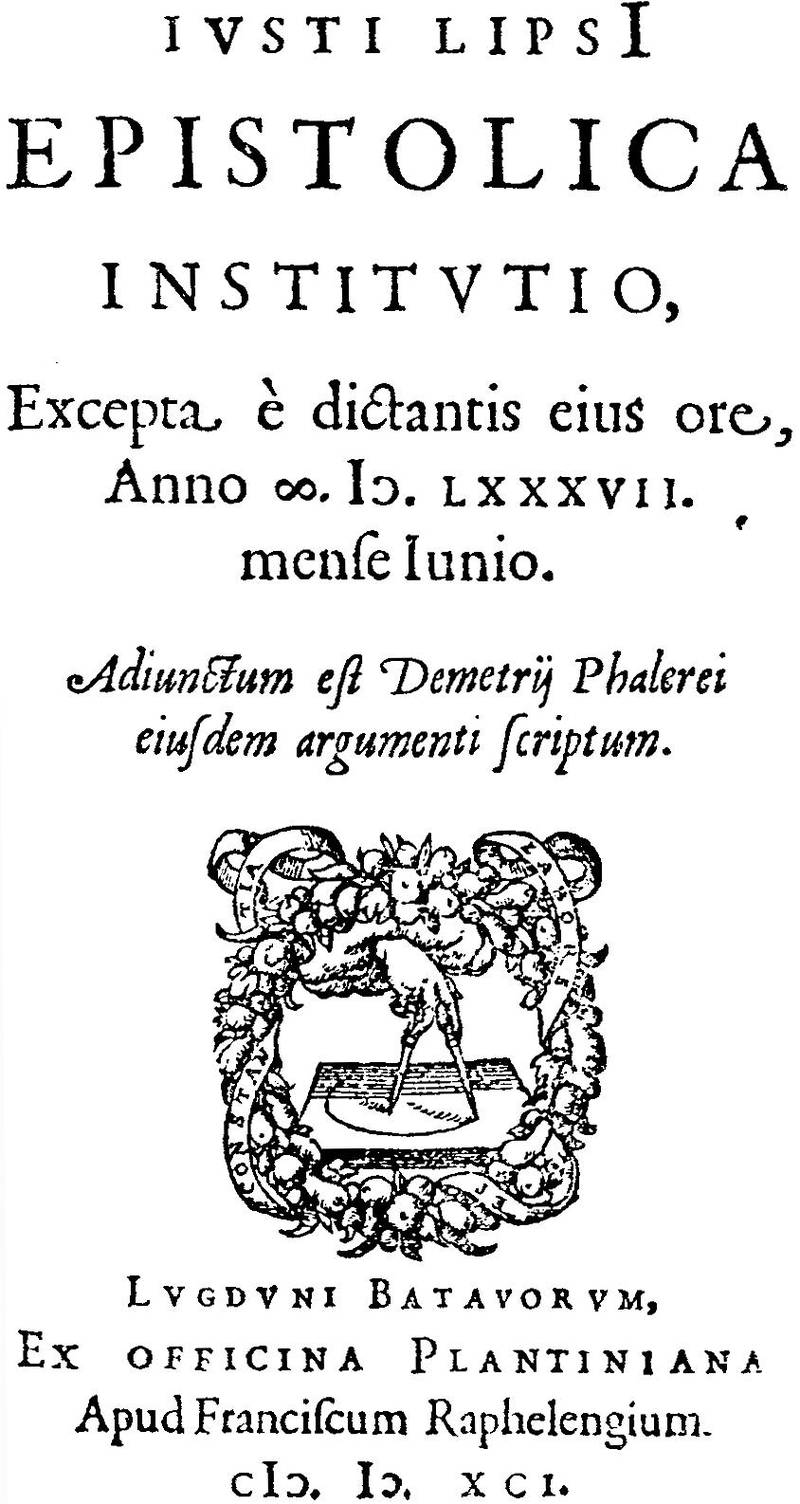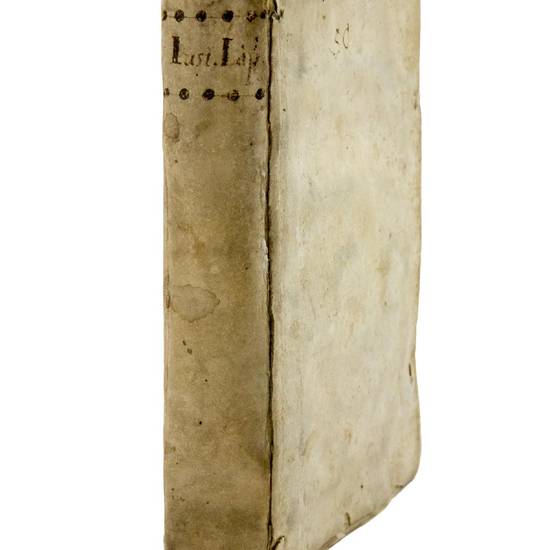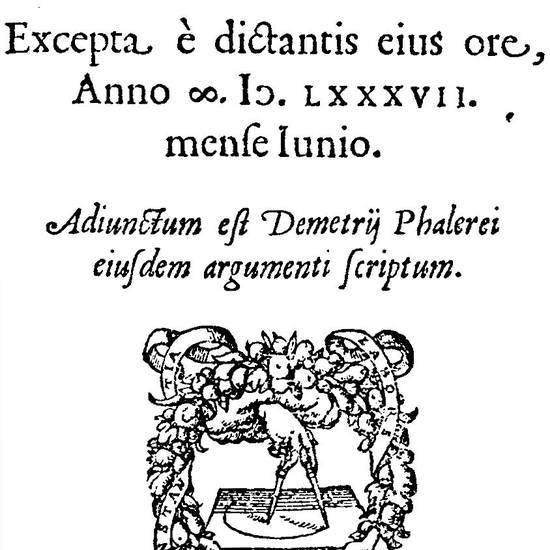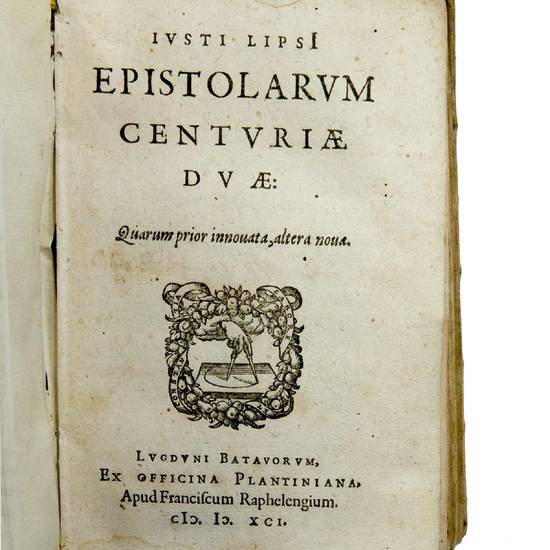Epistolica institutio, Exepta è dictantis eius ore, Anno M.D. LXXXVII. Mense Iunio. Adiunctuum est Demetrij Phalerei eiusdem argumentum scriptum. [bound with:] Epistolarum centuriae duo. Leiden, Ex officina Plantiniana, Apud Franciscum Raphelengium, 1591.
Autore: LIPSIUS, Justus (1547-1606)
Tipografo: Franciscus Raphelengius
Dati tipografici: Leiden, 1591
Two works in one volume, 8vo.
I. EPISTOLICA INSTITUTIO:
44, (4) pp. A-C8 (C7 and C8 are blank). With the printer's device on the title page. Contemporary vellum with inked title on spine.
Green & Murphy, p. 275; Gueudet, pp. 370-371; J. Rice Henderson, Humanist Letter Writing: Private Conversation or Public Forum?, in: “Self-presentation and Social Identification. The Rhetoric and Pragmatics of Letter Writing in Early Modern Times”, T. Van Houdt, J. Papy, G. Tournoy & C. Matheeleussen, eds., (Leuven, 2002), p. 37.
ORIGINAL EDITION (a quarto edition with different pagination was simultaneously issued by the same printer) of Lipsius' letter-writing manual originated from a lecture held in June 1587. To Lipsius' treatise is appended a bi-lingual edition of Demetrius' description of the classical familiar letter. The work was reissued in 1601, again in quarto and in octavo, and in 1605, in quarto only. These editions are the only printings of the work during the author's lifetime that he supervised. Until the end of the century the work was also printed in other countries, evidently without Lipsius' authorization, first at Frankfurt/M. (1591) and then at Lyon (1592, 1596), Magdeburg (1594), Cologne (1596, 1597), and Paris (1599) (cf. Justus Lipsius, Principles of Letter-Writing: A Bilingual Text of ‘Justi Lipsii Epistolica Institutio', R.V. Young & M.T. Hester, eds., Carbondale, IL, 1996, pp. xlviii-il).
“In 1591 Lipsius allowed Raphelengius to publish his Epistolica Institutio, which in its sixteen printed leaves completed the liberation of epistolography from the rules of rhetoric. His recommendations are generally models of brevity and lucidity, composed according to the principles established by his predecessors, in particular Vives, whose interest in the psychology of the writers of letters and their recipients found a sympathetic response in Lipsius. He did not need the rules of Francesco Negri, nor even of Erasmus and Vives” (M. Morford, Lipsius' Letters of Recommendation, in: “Self-presentation and Social Identification. The Rhetoric and Pragmatics of Letter Writing in Early Modern Times”, T. Van Houdt, J. Papy, G. Tournoy & C. Matheeleussen, eds., Leuven, 2002, p. 189).
“Lipsius clearly devoted the first ten chapters of his Institutio to the epistolary ars; the last three may be regarded as personal admonitions to the artifex [...] ‘graded' for the youthful, the more mature, and the adult student, and departing progressively from Ciceronian basis recommended to the first group. There are also admonitions for keeping a notebook or commonplace book in the Renaissance manner. Such material belongs under the caption of artifex and thus entitles the 0 to placement in the isagogic category by its principle to structure as much as by its address to the young [...] Lipsius attempted to drive a sharp wedge between the letter, properly so called, and other written communications which had long borne the name of letter incorrectly. He made a threefold division of letters according to subject matter: ‘materies seria', ‘materies docta', and ‘materies familiaris'. The first dealt with public or private matters of gravity, the second with technical or learned questions. If I interpret him correctly, he regarded the first essentially an oration, the other essentially a treatise. He then turned to the genuine letter, the ‘materies familiaris' designating it by the adjective ‘propria'. Of this type of subject his says: ‘Denique familiarem dico, quae res tangit nostras aut circa nos, quaeque in assidua vita. Ea propria et creberrima Epistolae materies: &, si verum fateri volumus, germanaem illius una'. Having limited the genuine letter to the familiar kind, Lipsius proceeded to detach it more definitely from oratorical associations evident in the Renaissance epistolary manuals. In Chapter VI of the Institutio, for all practical purposes, he rejects for the letter the first two parts of traditional rhetoric, viz. inventio and dispositio (the latter he calls ordo). Why, he asks, should he burden the reader with rules of invention or the selection of ideas? One who writes a letter, a genuine letter, always comes to his task bearing a message. As for ordo or dispositio, the less it is evident, the more charming the letter” (E.C. Dunn, Lipsius and the Art of Letter-Writing, in: “Studies in the Renaissance”, 3, 1956, pp. 148-149 and 151-152).
P. Martín Baños (El arte epistolar en el Renacimiento europeo 1400-1600, Bilbao, 2005, pp. 631-637) argues that Lipsius in the Institutio epistolica was not influenced by Hermogenes' Ideas, as some scholars claim, but that Pedro Juan Núñez in his Institutiones rhetoricae (1585) has. Martín Baños considers this influence a unique case in Renaissance epistolary theory.
II. EPISTOLARUM CENTURAE DUAE:
304 (i.e 312) pp. A-L8, M4. With the printer's device on the title-page.
J. de Landtsheer, Justus Lipsius, 1547-1606, and the Edition of his ‘Centuriae miscellaneae', 1586-1605; some Particularities and Practical Problems, in: “Lias”, 25, 1998, p. 78; A. Pettegree & M. Walsby, eds., Netherlandish books: books published in the Low Countries and Dutch books published abroad before 1601, Leiden, 2011, II, p. 842, no. 19328.
RE-ISSUE of the first edition of 1590 (it was reprinted at Frankfurt/M in 1591, Lyon in 1592 and 1596, London in 1593, and Paris in 1599).
“The second part is a new Centuria of letters dedicated to Baron Cecil Burghley, Governor of den Briel [dated April 11, 1590], who has shown great courage and skill both in pace and in wartime. The whole collection was written by Lipsius, with the exception of two letters that came from Josephus Justus Scaliger and his father Julius Caesar [...] This new Centuria got Lipsius into trouble, for three letters [13, 14, 15] inserted, which Lipsius had written during his sojourn in Oldenburg [Westphalia] and in which he had poked fun at the way of life he was confronted with. When [...] the collection was dispersed all over the empire, it stirred up bad blood among the Westphalians. One of them, Johannes Domannus, had his retort ready at the Frankfurt September book fair of 1591, an angry pamphlet to defend his country's honour. Lipsius did not feel tempted to start a paper war, but he apologized in letters to two German acquaintances, men of influence, viz. the Silesian humanist Jacobus Monavius and Henricus Ranzovius, a nobleman and governor of Schleswig-Holstein: he had never had the intention to trample on the Germans' feelings, and definitely not to offend the Emperor; his jokes and their phrasing might have been somewhat ill-considered” (J. de Landtsheer, op. cit., pp. 75-77).
(Centuria I, which contains mostly the same letters as the editio princeps of 1586, excepted the following:)
(letter) VII from Scaliger, Julius Caesar is replaced by one to Pithou, Pierre, Louvain, January 17, 1577 (p. 19)
IX to Giselinus, Victor is replaced by another letter to him, August 31, n.y. (p. 28)
X to Ellinger, Andreas is replaced by one to Lernutius, Janus, Leiden, September 12, 1582 (p. 28)
XI from Muret, Marc-Antoine is replaced by one to Gulielmius, Joannes, Leiden, August 11, 1580 (p. 29)
XVII from Busbecq, Ogier [Ghislain de] is replaced by one to Grotius, Jan, Leiden August 2, [1586] (p. 37)
XXIV from Rataller, Georgius is replaced by one to Camden, William, Leiden, July 29, 1586 (p. 53)
XXIX from Scaliger, Julius Caesar is replaced by one to Teeling, Theobald, Leiden, August 14, n.y. (p. 61)
XXX to Florentius, Nicolaus is replaced by one to Biesius, Nicolaus, [June, 1572?] (p. 61)
XXXIV from Busbecq, Ogier [Ghislain de] is replaced by one to Lernutius, Janus, October 1, 1585 (p. 67)
XXXVIII from Gulielmius, Joannes is replaced by one to Jonston, John, Leiden, March 22, 1588 (p. 72)
XLV to Giselinus, Victor replaced by one to Schott, Andreas, July 7, 1582 (p. 82)
XLVI from Roeland, Gabriel is replaced by one to Pollio, Everhart, Leiden, August 8, 1581 (p. 83)
IL from L'Escluse, Charles de is replaced by one to Vivien, Jean, Leiden, 1584 (p. 86)
LIII from Muret, Marc-Antoine is replaced by another letter to him, Leiden, November 29, 1581 (p. 107)
LVII from Marnix, Philip is replaced by one to Burch, Adrian van der, Leiden, January 28, [1586] (p. 112)
LXVII to Egmond [Nieuwenburg], Cornelis van is replaced by one to Cujas, Jacques, Leiden, October 5, [1586] (p. 130)
LXIX to Dammius, Adrianus is replaced by one to Lydius, Martinus, Leiden, June 28, 1585 (p. 132)
LXXVI to Dunellus [Doneau], Hugues is replaced by one to Cujas, Jacques, Leiden, April 5, 1585 (p. 140)
LXXXIV from Pincaeus, Renatus is replaced by one to Canter, Theodor, Leiden April 5, 1585 (p. 152)
XCI from Dudith, Andreas is replaced by one to L'Escluse, Charles de, Leiden, October 26, n.y. (p. 165)
XCVI from Torrentius [Beken, van der], Laevinus is replaced by one to Dousa, Janus, Leiden, September 1, 1585 (p. 172)
(Centuria II:)
Turnèbe, Adrien. [Leiden], March 16, [1585] (p. 189)
Giselinus, Victor. Leiden, May 18, 1581 (p. 190)
Thou, Jacques Auguste de. Leiden, February 11, 1586 (p. 191)
Villiers, Pierre de, the Younger. Leiden, April 1, 1586 (p. 192)
Corbinelli, Jacopo. Leiden, 1586 (p. 193)
Burch, Lambert van der. Leiden, January 16, 1586 (p. 194)
Raphelengien, François, the Younger. [Leiden], November 16, 1586 (p. 196)
Wilt, Hendrick van. [Leiden], April 16, 1586 (p. 197)
Lernutius, Janus. [Leiden], May 18, 1581 (p. 198)
Villiers, Pierre de. Leiden, April 1, 1586 (p. 200)
Groslot, Jérôme. Leiden, April 26, 1586 (p. 201)
Leoninus, Elbert. Oldenburg, October 7, 1586 (p. 201)
Dousa, Janus. [Oldenburg], October 5, 1586 (p. 203)
Hout, Jan van. Oldenburg, October 30, 1586 (p. 203)
Heurnius, Joannes. Emden, October 15, 1586 (p. 204)
Colvius, Petrus. [Oldenburg], October 7, 1586 (p. 207)
Pollio, Everart. February 27, [1589] (p. 207)
Junius, Franciscus. Leiden, [1588] (p. 209)
Lampsonius, Dominicus. June 19, 1587 (p. 210)
Leeuwius, Theodorus. January 2, 1587 (p. 213)
Cujas, Jacques. Leiden, March 16, 1587 (p. 213)
Lernutius, Janus. [Leiden], August 31, 1587 (p. 214)
Rosendael, Aemilius. Leiden, June 30, 1587 (p. 215)
Savaria, Adrianus. March 23, 1588 (p. 216)
Scaliger, Jusephus Justus. Leiden, April 21, 1588 (p. 217)
Regemorter, Petrus. Leiden, January 24, [1588] (p. 218)
Baudier, Dominique. May 5, 1587 (p. 219)
Clusius, Carolus [L'Ecluse, Charles de]. January 14, 1588 (p. 221)
Arcerius, Joannes. Leiden, January 13, 1588 (p. 222)
Stuck, Johann Wilhelm. August 22, 1590 (p. 223)
Mylius, Abraham. Leiden, June 1, [1585] (p. 224)
Plantin, Christoffel. Leiden, August 29, [1585] (p. 226)
Marcilius, Theodorus. Leiden, May 29, 1587 (p.227)
Melissus [Schade], Paul. Leiden, June 1, 1587 (p. 228)
Mercier, Josias. Leiden, September 22, 1587 (p. 229)
Duystius, Joannes. Leiden, June 1, 1587 (p. 230)
Gothofredus, Dionysius. Leiden, August 13, 1587 (p. 231)
Raphelengien, François, the Younger. Leiden, August 31, 1588 (p. 232)
Frischlin, Nicodemus. Leiden, January, 1587 (p. 234)
Nansius, Franciscus. May 31, 1586 (p. 235)
Ortelius, Abraham. July 6, 1587 (p. 236)
Dresser, Matthias. September 2, 1588 (p. 237)
Pollio, Everhart. September 2, 1588 (p. 237)
Alostanus, Petrus. April 2, 1587 (p. 239)
Montaigne, Michel de. Leiden, April 15, 1588 (p. 240)
Bernardi, Théodore. Leiden, February 28, n.y. (p. 241)
Leeuwius, Theodorus. Leiden, September 21, 1587 (p. 241)
Dousa, Janus (p. 243)
Scaliger, Josephus [Justus] to Vertunianus, Franciscus. Agen, May 31, n.y. (p. 243)
id. to Ferrier, Auger. Agen, July 6, n.y. (p. 244)
Mercuriale, Girolamo. September 2, 1588 (p. 247)
Culenius, Lambertus. July 22, [1587] (p. 248)
Regemorter, Petrus. September 20, [1588] (p. 249)
Lampsonius, Dominicus. Leiden, June 17, 1588 (p. 251)
Gruter, Janus. Leiden, August 31, [1587] (p. 252)
Raphelengien, François, the Younger. Leiden, April 26, 1588 (p. 254)
Lernutius, Janus. March 10, 1588 (p. 256)
Wilt, Hendrick van. Leiden, April 29, 1589 (p. 257)
Montaigne, Michel de. Leiden, August 30, [1588] (p. 258)
Gournay, Marie de. Leiden, [1589] (p. 259)
Dousa, Janus (p. 261)
Bourbon, Henri de. August 1, n.y. (p. 265)
Ortelius, Abraham. Leiden, December 10, 1588 (p. 265)
Pauw, Petrus. November 14, [1589] (p. 266)
Thou, Jacques Auguste de. Leiden, June 3, [1588] (p. 268)
Canter, Theodorus. Leiden, September 2, 1588 (p. 269)
Gonzales de Cunedo, Josè. Leiden, November 8, 1588 (p. 270)
L'Hopital, Michel Heurault de. September 3, n.y. (p. 272)
Raphelengien, François, the Younger. Leiden, October 29, 1588 (p. 273)
Brach, Pierre de. [1588] (p. 274)
Lernutius, Janus. September 9, 1588 (p. 275)
Leeuwius, Theodorus. Leiden, March 26, [1590] (p. 277)
Morel, Frédéric. Leiden, December 8, 1588 (p. 278)
Saravia, Adrianus. July 30, [1588] (p. 280)
Raphelengien, François, the Younger. [Leiden], November 8, [1588] (p. 281)
Hildesheim, Franciscus. Leiden, August 2, [1589] (p. 282)
Plantin, Christoffel. [June, 1589] (p. 283)
Raphelengien, François, the Younger. July 16, 1589 (p. 283)
Benci, Francesco. Leiden, August 31, 1588 (p. 284)
Tuning, Gerard. Leiden, November 27, [1587] (p. 285)
Canter, Theodorus. October 12, [1588] (p. 286)
Monau, Jacob. June 5, [1589] (p. 287)
Calvardus, Laevinus. August 16, 1589 (p. 288)
Baudier, Dominique. July 15, 1589(p. 289)
Forgách, Mihály. June 5, 1589 (p. 290)
Criep, Willem. Leiden, March 16, n.y. (p. 291)
Arcerius, Joannes. Leiden, August 20, 1589 (p. 292)
Casaubon, Isaac. Leiden, August 6, [1589] (p. 293)
Marnix, Philippe. Leiden, September 30, [1589] (p. 293)
Lampsonius, Dominicus. Leiden, August 14, 1589 (p. 294)
Raphelengien, François, the Younger. July 20, 1589 (p. 295)
Vosbergen, Casper. Leiden, August 20, 1589 (p. 296)
Chytraeus, Nathan. Leiden, March 15, 1590 (p. 297)
Lydius, Martinus. Leiden, March 16, [1590] (p. 298)
Gruter, Regnerus. Leiden, August 11, 1589 (p. 299)
Montaigne, Michel de. September 17, [1589] (p. 300)
Oudaert, Nicolas. November 9, 1589 (p. 300)
Blotius, Hugo. Leiden, March 15, [1590] (p. 301)
Reid, Everhart van. Leiden, February 18, 1590 (p. 302)
Browne, Lancelot. [1589] (p. 303)
Also bound with: Lipsius, De recta pronunciatione latinae linguae dialogus [Antwerp, Plantin, 1596], which is usually found as an appendix to Lipsius' Opera omnia quae ad criticam proprie spectant (Antwerp, Plantin, 1596); it was first published in 1586 with a dedication to Sir Philip Sidney.
Born near Louvain in the town of Overlise, Justus Lipsius distinguished himself as a student of the classics first at the Jesuit college at Cologne and subsequently at the university in Louvain. Shortly after completing his studies, he published a precocious volume of Variae Lectiones (1569), a collection of philological observations on classical texts. Written in a polished Ciceronian style and dedicated to no less a figure than Cardinal Granvelle, chief minister of Philip II in the Low Countries, the volume quickly captured the attention not only of the powerful prelate but also of Europe's scholars.
This initial work had significant and lasting effects on Lipsius' career; the most immediate was his appointment as Latin secretary to Granvelle, who took the young man to Rome, where he was introduced to international power politics as well as to the treasures of Italian libraries, including the Vatican's. An equally significant result of the cardinal's patronage was the opportunity it afforded Lipsius to make the acquaintance of Marc-Antoine Muret, the French scholar who was perhaps the most famous Latinist of his age.
A recent convert to the anti-Ciceronian movement, Muret in turn made a convert of Lipsius. The first fruit of this interest was Lipsius' famous edition of Tacitus (1575), and its culmination was Politicorum libri sex (1589), a compilation of classical political wisdom directed explicitly at the social and religious crises of the sixteenth century. These works won him a reputation as a ‘politician', or student of prudentia, which was never equaled or corrected, at least in Italy, by the fame of his later works.
A corollary interest was the style and philosophy of Seneca. Lipsius' most famous and influential work, De constantia (1584), is a synthesis of Christianity and Stoic philosophy. The crowning achievement of his career are two studies of Stoicism, Manuductio ad stoicam philosophiam and its sequel Physiologia stoicorum (both 1604), and his monumental edition of Seneca (1605).
After two years in the service of the cardinal, Lipsius returned briefly to Leuven, only to leave again in 1571, apparently fearing the strife that had broken out anew between his countrymen and their Spanish rulers. He went to the Viennese court of Maximilian II, where he met such renowned literary figures as Ogier Busbecq, Joannes Sambucus, Joannes Crato, and Stephanus Pighius, who urged that he stay in Vienna. He was unable to find the kind of patronage for which he had hoped, however, and he moved on to Bohemia, Meissen, and Thuringia. While in Thuringia, news of continued turmoil in Brabant deterred his return home, so he secured a recommendation from the Protestant scholar Joachim Camerarius, whom he had met in Leipzig, and this led to an invitation from the Duke of Saxe-Weimar to serve as professor of history at the Lutheran University of Jena in 1572.
Popular among students, Lipsius aroused the jealousy of elder colleagues and the suspicion of Protestant authorities. In March 1574, he left Jena for Cologne and evidently made his peace with the Church. It was in Cologne that he wrote five books of Antiquae lectiones, which are almost exclusively concerned with an enthusiastic examination of Plautus. After a few months, Lipsius returned to Leuven, and in 1576 he proceeded to the degree of doctor of laws, an undertaking that has been ascribed to his association with Muret and an interest in jurisprudence derived from Tacitus. In addition to resuming his work on Tacitus during this brief residence in his homeland, he also published his important Quaestiones epistolicae (1575).
But Lipsius was not yet to find peace. In 1578, with the news of the victory of Don Juan of Austria at Gembloux, he again became apprehensive at the prospect of an invasion by Spanish troops. He fled Louvain, and Spanish soldiers did indeed ransack his deserted house, confiscating and destroying his books and papers. He took brief refuge in the Antwerp home of his friend and publisher, Christopher Plantin. Then, in 1579, he accepted the temporary position of professor of history and law at the Leiden University.
Notwithstanding its explicitly Calvinist make-up, Leiden was a remarkably open university in the beginning, and in Holland Lipsius found a haven from his home province for nearly thirteen years. While there he published his Electa (1580); his Satyra Menippaea: Somnium (1581); his Saturnalia (1582); his De Amphitheatro (1584); his De Amphitheatris quae extra Romam (1584); notes on Valerius Maximus, Seneca, and Velleius Paterculus; and his De recta pronuciatione Latinae Linguae (1586); as well as the major works on constancy and politics. It was there, also, that he delivered the lectures on letter-writing that later became Epistolica institutio of 1591.
By 1591, however, the atmosphere, if not the statutes, of Leiden had become more stridently Calvinist, and Lipsius returned to the southern provinces of the Low Countries, where he was again reconciled to the Catholic Church, largely through the good offices of his boyhood masters, the Jesuits, and he accepted the post of professor of Latin at Leuven. He remained in Leuven for the rest of his days, resisting numerous appeals from foreign courts and especially from Italian churchmen (cf. M. Laureys, ed., The World of Justus Lipsius: A Contribution Towards his Intellectual Biography: Proceedings of a colloquium held under the auspices of the Belgian Historical Institute in Rome, Rome, 22-24 May 1997, Bruxelles, 1998, passim; and H.D.L. Vervliet, Lipsius' jeugd, 1547-1578: analecta voor een kritische biografie, in: “Mededelingen van de Koninklijke Vlaamsche Academie voor Wetenschappen, Letteren en Schone Kunsten van België, Klasse der Letteren”, 31/7, 1969, pp. 9-12).
[9030]

